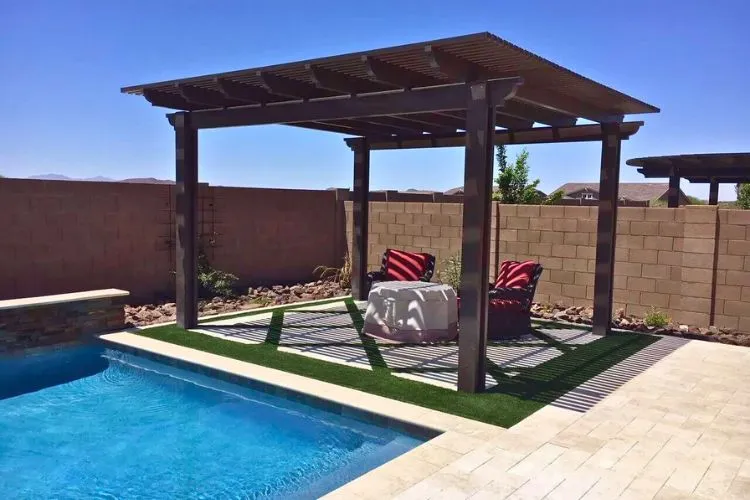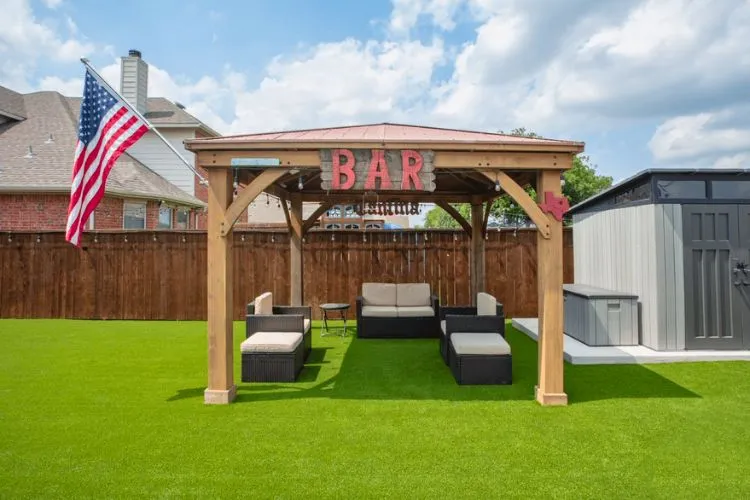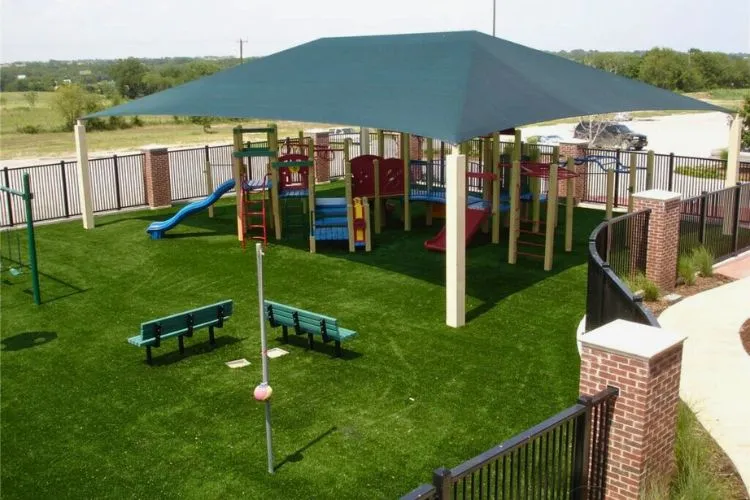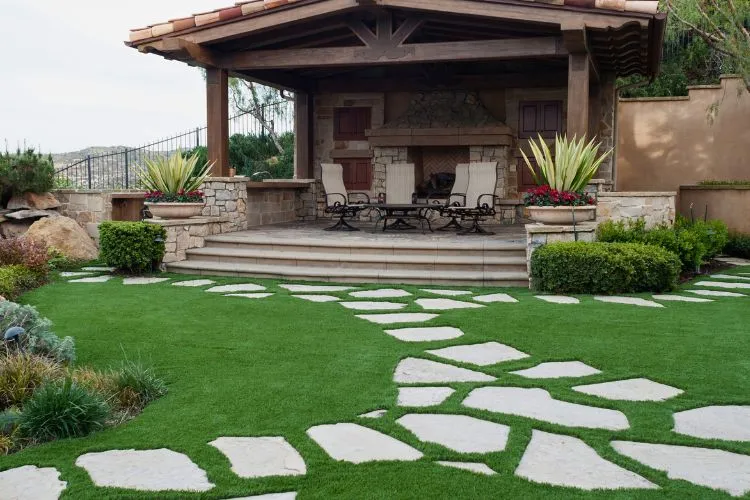Transforming your backyard into a versatile outdoor living space is a goal for many homeowners. One popular question that arises is, can you put a gazebo on artificial grass? The straightforward answer is yes, you can.
However, doing it right is crucial for both the appearance and longevity of the gazebo and the artificial turf. This article serves as your definitive guide for installing a gazebo on artificial grass effectively.

Contents
- 1 Can You Put a Gazebo on Artificial Grass?
- 2 Considerations Before Installation
- 3 Step-by-Step Guide to Installing a Gazebo on Artificial Grass
- 4 Maintenance and Care
- 5 Legal and Zoning Considerations
- 6 Frequently Asked Questions (FAQs)
- 7 Impact of Foot Traffic on Artificial Grass
- 8 Seasonal Considerations for Gazebo on Artificial Grass
- 9 Enhancing the Gazebo Experience with Accessories
Can You Put a Gazebo on Artificial Grass?
Choosing artificial grass as a base for your gazebo installation brings several advantages.
Firstly, artificial turf remains green and vibrant all year round, ensuring that your gazebo always looks inviting, irrespective of the season. Unlike natural grass, it doesn’t require water, fertilizer, or regular mowing, making it a low-maintenance option.
This combination not only enhances the aesthetic appeal of your garden but also provides a durable and clean area for family gatherings, relaxation, and entertainment.
Considerations Before Installation
Before moving forward with your project, it’s essential to address a few key aspects.

Type and Quality of Artificial Grass
Not all artificial turfs are created equal. The type you choose should be able to withstand the weight of the gazebo without compressing or damaging over time.
Higher-density options tend to be more durable. Besides the weight factor, consider the look and feel you desire as the grass will contribute significantly to the overall ambiance.
Size and Type of Gazebo
Gazebos come in diverse sizes and materials. It’s essential to match the gazebo’s characteristics with the capabilities of the artificial grass. A heavier or permanent gazebo will require more preparation than a light, temporary structure.
Ground Preparation
Ensuring that the ground underneath is level and stable is vital. An uneven base can lead to water pooling under the gazebo or an unstable structure that could potentially be unsafe.
Weather and Drainage Factors
While artificial grass allows water to drain through, placing a large structure on top can hinder this process. Factor in your area’s typical weather conditions and consider drainage solutions to prevent water accumulation.
You may also like: Can You Put A Gazebo On Grass?
Step-by-Step Guide to Installing a Gazebo on Artificial Grass

Preparing the Site
The first step is to define where your gazebo will go. Clear this area of any debris or stones. For the best result, you should level the ground. This might require removing the existing turf, compacting the soil beneath, and ensuring it is flat and firm.
Laying the Foundation
A solid foundation is key to the longevity of your gazebo. You may opt for a concrete slab, paving stones, or a wooden base, depending on the gazebo’s weight and your personal preference. This step is crucial for permanent or semi-permanent structures to prevent sinking or tilting.
Assembling the Gazebo
With the foundation set, you can now assemble your gazebo according to the manufacturer’s instructions.
During this process, take care not to drag parts across the artificial grass, as this could cause damage. It might be helpful to have an extra pair of hands to hold pieces in place as you secure them together.
Securing the Gazebo
Securing your gazebo properly will protect it from being moved by the wind. Anchoring options vary from heavy-duty tent pegs designed for artificial turf to more permanent solutions like bolting the gazebo directly to its base. The best method depends on the gazebo’s type and your foundation choice.
Maintenance and Care
To keep both your gazebo and artificial grass looking their best, a little maintenance goes a long way. Regularly checking the structure for any signs of wear or damage ensures safety and longevity.
To care for the artificial turf, gently rake leaves and debris to avoid accumulation. A gentle wash can remove dust or spills from the surface.
Legal and Zoning Considerations
When planning to install a gazebo on artificial grass, one key area that cannot be overlooked is compliance with local regulations. Every municipality has its own set of building codes, zoning laws, and permit requirements designed to ensure safety, preserve community aesthetics, and manage land use.

It’s important for homeowners to visit their local building department or consult the town’s official website to gather information on the necessary paperwork and guidelines.
This may involve submitting detailed plans for the structure, indicating size and location, and even notifying neighbors about the proposed project. Navigating these regulations effectively will prevent costly modifications down the line and ensure that the gazebo installation is carried out legally and safely.
It’s not just about adhering to the rules; it’s about contributing to the neighborhood’s well-being and ensuring that your haven of relaxation is secure and legitimate.
Frequently Asked Questions (FAQs)
How to choose the right type of artificial grass for under a gazebo?
Look for high-density options that can withstand the weight and frequent use. Consider the pile height and color that match your aesthetic preferences.
Can you install a gazebo on artificial grass without damaging it?
Yes, by using proper ground preparation and choosing the right foundation, you can install a gazebo without harming the artificial turf.
Do I need a special permit to install a gazebo on artificial grass?
It depends on your local regulations. Always check with your local planning office before proceeding with your installation.
Tips for maintaining artificial grass under a gazebo?
Regularly remove debris and give the area a light wash. For areas with little rainfall, occasional watering will help to clear away dust.
Impact of Foot Traffic on Artificial Grass
When placing a gazebo on artificial grass, it’s essential to consider the impact of foot traffic around the structure.
High foot traffic areas can lead to wear and tear on the turf, causing it to flatten or degrade over time. Here are some tips to manage this:
Reinforcing High-Traffic Areas:
- Pathways: Create designated pathways using stepping stones, pavers, or gravel around the gazebo to minimize direct contact with the artificial grass.
- Protective Mats: Place protective mats or rugs at the entrance and exit points of the gazebo to reduce wear on the turf.
Regular Maintenance:
- Brushing: Regularly brush the artificial grass fibers to keep them upright and looking fresh. This helps maintain the turf’s appearance and durability.
- Cleaning: Periodically clean the artificial grass using a mild detergent and water to remove dirt and debris. Rinse thoroughly to avoid any residue buildup.
Seasonal Considerations for Gazebo on Artificial Grass
Different seasons bring varying challenges to maintaining a gazebo on artificial grass. Here’s how to address these seasonal changes:
Spring and Summer:
- UV Protection: Prolonged exposure to sunlight can cause artificial grass to fade. Opt for UV-resistant artificial grass to maintain its color and integrity.
- Cooling Measures: During hot weather, the surface of artificial grass can become warm. Use shade solutions, such as additional canopies or pergolas, to keep the area cool and comfortable.
Fall and Winter:
- Leaf and Debris Removal: Regularly remove fallen leaves and debris to prevent them from accumulating and potentially damaging the artificial grass.
- Snow and Ice Management: Avoid using metal shovels or sharp tools to clear snow and ice, as they can damage the turf. Instead, use a plastic snow shovel or a broom to gently remove snow.
Enhancing the Gazebo Experience with Accessories
Adding accessories to your gazebo can enhance its functionality and aesthetic appeal. Consider these additions:
Lighting Solutions:
- String Lights: Install LED string lights around the gazebo to create a warm and inviting atmosphere during the evening.
- Solar Lights: Use solar-powered lights to illuminate the area without the need for electrical wiring. These lights are energy-efficient and easy to install.
Furniture and Decor:
- Outdoor Furniture: Choose comfortable and weather-resistant furniture that complements the gazebo and artificial grass. Opt for pieces made from materials such as wicker, aluminum, or teak.
- Decorative Elements: Add decorative elements like outdoor rugs, cushions, and potted plants to personalize the space and make it more inviting.
Climate Control:
- Fans and Heaters: Install outdoor fans to keep the area cool during the summer months. For cooler seasons, consider using patio heaters to extend the usability of the gazebo.
- Misting Systems: Install a misting system around the gazebo to provide a refreshing cool mist during hot weather. This can significantly enhance comfort levels on warm days.
Conclusion:
Incorporating a gazebo into your artificial turf setup is not only feasible but also an excellent way to add value and function to your outdoor space.
By considering the type of grass and gazebo, preparing the ground properly, and following the steps for a secure installation, you can enjoy a beautiful and durable new area in your garden.
Remember, the effort you put into the planning and installation process will pay dividends in the longevity and appearance of your gazebo and artificial grass.

Sergio Gomes, a passionate advocate for outdoor living and the male voice behind Shades Authority. With years of experience, Sergio is your trusted source for expert insights on gazebos, pavilions, cabanas, pergolas, and all things outdoor shade solutions. Join him on a journey to transform your outdoor spaces into stunning, functional retreats
